Sobre la representación y comunicación de las ideas. Fotógrafías e imágenes | About representation and communication of ideas. Photographies and images
DOI:
https://doi.org/10.26754/ojs_zarch/zarch.201661452Abstract
Habitamos en un mundo dominado por la imagen. La abundancia y saturación de éstas distrae al espectador y no permite —en ocasiones— extraer las ideas que subyacen detrás de toda manifestación artística, incluida la arquitectura. A la hora de representar y comunicar cualquier idea, es muy importante ese estado intermedio que cabalga entre el análisis previo de las condiciones de partida y la propuesta final. Ese umbral entre un lugar y otro, que contiene las bondades de ambos, entendido como espacio de intercambio de valores. Y en ese mundo se mueven croquis, ideogramas, esquemas, diagramas y procesos, que extraen los resultados que interesan del análisis y anticipan las claves que residen en la propuesta.
Este artículo pretende analizar los cambios producidos en la representación y comunicación de las ideas arquitectónicas y, en concreto, la crucial importancia adquirida por la imagen generada digitalmente (render) frente a la información que la fotografía generaba en torno a la finalización de una construcción, aunque aquella solo suponga el mero anuncio de su (posible) realización. Las imágenes digitales —de aspecto decididamente hiperrealista— anticipan arquitecturas aún inexistentes y, en este sentido, representan claramente ideas no construidas —pero sí en cambio visualizadas— que aparecen ante nuestros ojos dotadas de un halo de perfección ideal.
We live in a world dominated by the image. The abundance and saturation of these distracts the viewer and does not allow, in occasions- extract the ideas that underlie all artistic expression, even the architecture. When it comes to represent and communicate any idea, it’s very important this intermediate state that rides between the previous analysis of the starting conditions and the final proposal. These thresholds between one place and another, that hold the benefits of both, understood as a space for exchange of values. And in this world we can find sketch, ideograms, diagrams, and process, that extract the results of the analysis and anticipate the keys that residing in the proposal.
This article tries to analyze the changes done in the representation and communication of the architectural ideas and, in concrete, the crucial importance taken by the digitally generated image (render) versus the information generated by the photography around the completion of a building, although the render only assume the mere announcement of his (possible) realization. The digitally images —with a decided hyperrealist look— anticipate non-existent architectures yet and, in this sense, they clearly represent non-built ideas —but in exchange viewed— that appearing in front of our eyes equipped with a halo of ideal perfection.





